1. Mandatory Dress Codes for Girls (And Not for Boys)
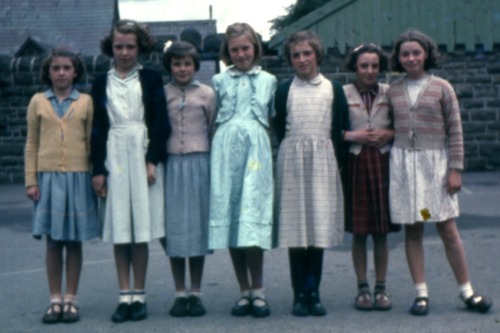
In the 1950s, many American schools had strict dress codes that prohibited girls from wearing pants, according to HubPages. Instead, they were required to wear skirts or dresses, regardless of the weather or practicality. This rule was enforced under the belief that feminine attire was essential for maintaining “proper” decorum and discipline. Girls who violated the dress code could be sent home or disciplined, reinforcing the idea that their appearance mattered more than their comfort.
At the same time, boys were allowed to wear trousers with little to no restrictions. The expectation that girls should always wear skirts was not only impractical but also deeply rooted in gender stereotypes. Many girls found this rule frustrating, especially during outdoor activities or cold weather. Today, such dress codes would be widely condemned as sexist and unfair, as most schools now allow students to dress comfortably regardless of gender.
2. No Talking in Class
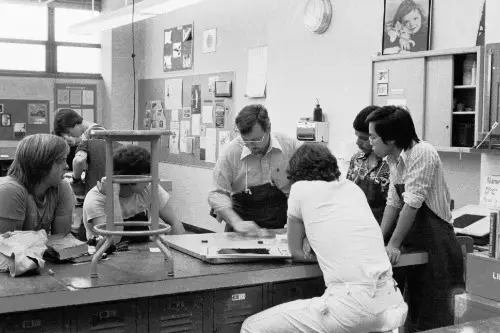
Classroom silence was strictly enforced in the 1950s, and students were expected to remain quiet unless directly spoken to by a teacher. According to Medium, the belief that children should be “seen not heard” was strong. Teachers believed that absolute silence maintained order and respect, ensuring that students absorbed information without distractions. Any violation of this rule could result in harsh punishment, including detention, writing lines, or even physical discipline.
This approach completely ignored the importance of student interaction and discussion in learning. Today, many educators encourage classroom participation, debates, and group activities to foster critical thinking. The rigid silence rule of the 1950s would be considered detrimental to student engagement and communication skills. Modern teaching methods emphasize collaboration, recognizing that conversation can be an essential part of the learning process.
3. Punishments for Left-Handed Students

Being left-handed was often seen as a defect in the 1950s, and many schools tried to “correct” it, according to TIME Magazine. Teachers would force left-handed students to write with their right hand, sometimes even tying their left hand behind their back. This practice was based on outdated beliefs that left-handedness was associated with disobedience or even sinister tendencies. Some students developed long-term difficulties with handwriting and coordination due to these forced changes.
Modern science has since debunked these myths, and left-handedness is now recognized as a natural variation. The idea of punishing a child for their dominant hand would be seen as absurd and abusive today. Schools now provide left-handed desks and materials to accommodate students rather than trying to change them. Looking back, this practice highlights how deeply ingrained superstitions once influenced school policies.
4. Corporal Punishment Was Commonplace
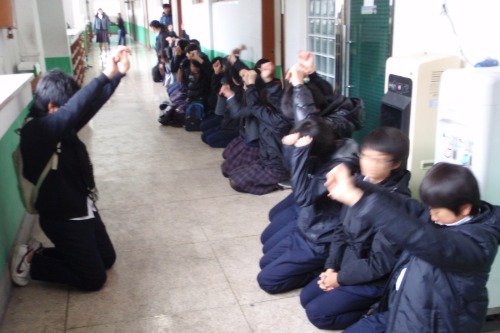
Spanking, paddling, and other forms of physical punishment were standard disciplinary measures in the 1950s, according to the NIH. Teachers and principals had the authority to strike students for infractions like speaking out of turn, forgetting homework, or minor misbehavior. Many believed that physical discipline instilled respect and obedience, and parents often supported the practice. However, this approach frequently led to humiliation, fear, and resentment among students.
Today, corporal punishment has been banned in most American schools, with research showing its harmful effects on children. Educators now emphasize positive reinforcement and conflict resolution instead of physical discipline. The shift reflects a broader understanding of child psychology and the importance of fostering a supportive learning environment. If a teacher today were to use corporal punishment, it would likely result in immediate dismissal and legal consequences.
5. Segregation in Schools
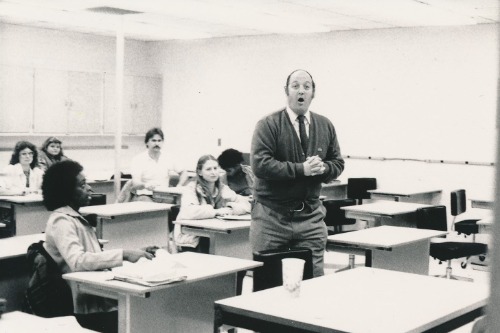
Despite the Supreme Court’s landmark 1954 ruling in Brown v. Board of Education, many American schools remained segregated well into the 1950s, according to Yale University. In parts of the South, Black and white students were still taught in separate classrooms, used different facilities, and had unequal access to resources. Some schools resisted integration by implementing stalling tactics, like closing public schools altogether or creating private academies for white students. Even in areas where integration was technically allowed, de facto segregation persisted due to housing policies and local resistance.
This blatant racial discrimination would be unthinkable today, as laws now require schools to provide equal opportunities regardless of race. However, the legacy of segregation still lingers in educational disparities across the country. Schools today strive to promote diversity and inclusion, recognizing the immense harm caused by past segregation policies. The fight for educational equity continues, but the forced separation of students based on race is now universally condemned.
6. Teachers Acting as Parental Figures
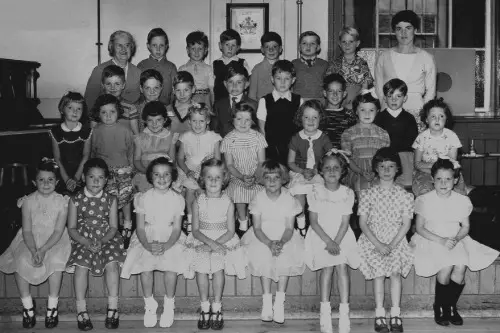
In the 1950s, teachers were often expected to take on roles that extended far beyond education. They monitored students’ behavior outside of school, disciplined them for home-related issues, and even intervened in family matters. Some teachers took it upon themselves to enforce moral codes, punishing students for actions deemed inappropriate—even if they had nothing to do with academics. This level of authority blurred the lines between education and personal life, giving teachers an almost parental role.
Today, such an expectation would be considered an overreach and a violation of students’ personal boundaries. While teachers still provide guidance and mentorship, they are no longer seen as surrogate parents. Instead, schools now have counselors and social workers to help address personal or family issues. The shift reflects a growing awareness that education should focus on academics while respecting students’ autonomy.
7. No Personal Hygiene Products Allowed in School Bags
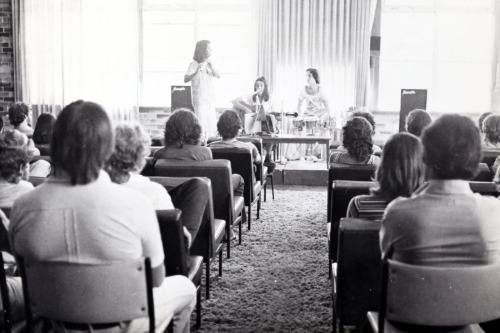
In many 1950s schools, students—especially girls—were not allowed to carry personal hygiene products, including sanitary pads or deodorant. The topic of menstruation was considered taboo, and discussing it openly could lead to embarrassment or even punishment. Some schools required girls to visit the nurse’s office for sanitary supplies, making an already uncomfortable situation even worse. The stigma around personal hygiene made it difficult for students to manage their basic needs with dignity.
Today, such a rule would be considered not just outdated but also harmful. Schools now provide free hygiene products in restrooms and promote open discussions about personal care. The shift has helped remove the shame associated with natural bodily functions and ensured that students can focus on learning without unnecessary stress. Banning hygiene products in schools today would spark outrage, as it disregards basic health and well-being.
8. “No Girls on the Playground During Boys’ Games”
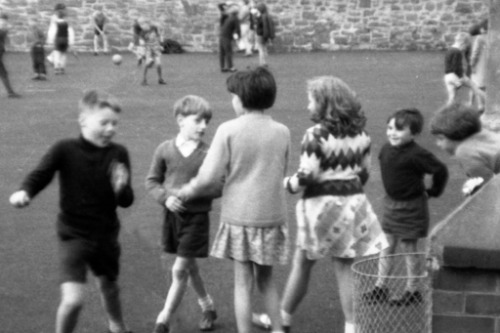
In many schools during the 1950s, girls were not allowed to participate in contact sports like football or baseball. Schools often designated separate, less physically intense activities for girls, such as cheerleading or dance. The belief was that girls were too delicate for rough play, reinforcing outdated gender stereotypes. Some schools even had separate gym classes with completely different curriculums for boys and girls.
Modern education has largely abandoned these restrictive policies in favor of equal opportunities in sports. Title IX, passed in 1972, ensured that girls had the same access to athletic programs as boys. Today, female students compete in every major sport, from wrestling to basketball, proving that athletic ability is not limited by gender. Looking back, the exclusion of girls from certain sports seems not just unfair but completely arbitrary.
9. Physical Education Participation Was Mandatory, But Only for Some

Physical education was a requirement in most 1950s schools, but boys and girls often had very different expectations. While boys participated in rigorous activities like push-ups, sprinting, and competitive sports, girls were often limited to light stretching, dance, or calisthenics. Some schools even excused girls from strenuous exercise altogether, reinforcing the idea that physical strength was only necessary for boys. These differences sent a clear message about gender roles and expectations.
Today, physical education programs are much more inclusive and balanced. Both boys and girls are encouraged to participate in a wide range of physical activities, with an emphasis on fitness and personal growth. Schools recognize the importance of physical activity for all students, regardless of gender. The days of assuming girls couldn’t handle exercise are long gone, replaced by an understanding that everyone benefits from staying active.
10. Long Hair Rules for Boys

In the 1950s, many schools enforced strict hair-length regulations for boys, requiring them to keep their hair short and neatly groomed. Long hair was associated with rebellion, delinquency, and countercultural movements, even though the hippie era hadn’t fully arrived yet. Some schools went so far as to conduct regular hair inspections, sending boys home if their hair was deemed too long. This rule was often justified under the pretense of maintaining discipline and ensuring that students looked “respectable.”
Modern attitudes toward personal appearance have changed dramatically, making such rules seem unnecessary and oppressive. Today, students are generally free to wear their hair however they choose, as long as it doesn’t interfere with learning. Long hair on boys is no longer seen as a sign of rebellion, and many schools have relaxed their grooming policies to respect personal expression. If a school tried to enforce strict hair-length rules today, it would likely face significant backlash from students and parents alike.
11. Strict No-Piercing Policies
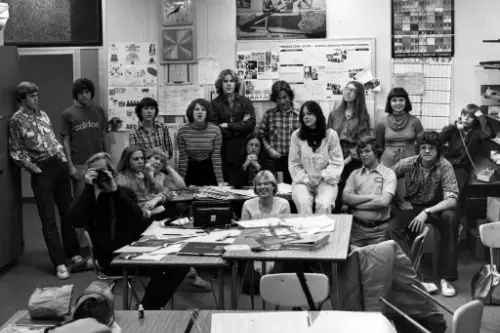
In the 1950s, many schools outright banned piercings, even small stud earrings on girls. The prevailing belief was that body piercings were inappropriate for young people and were associated with nonconformity. Any student who showed up with pierced ears could face disciplinary action, and in some cases, they were required to remove their earrings entirely. This rule reflected broader societal norms, where even adult women were sometimes discouraged from wearing noticeable piercings.
Today, piercings are widely accepted as a form of personal expression. Many schools allow students to wear earrings and even other facial piercings, as long as they are not disruptive. The idea that a tiny stud earring could impact a student’s education now seems outdated and unnecessary. With growing cultural acceptance of body modifications, strict anti-piercing rules have largely disappeared from school policies.
12. Teachers Were Allowed to Control Bathroom Access
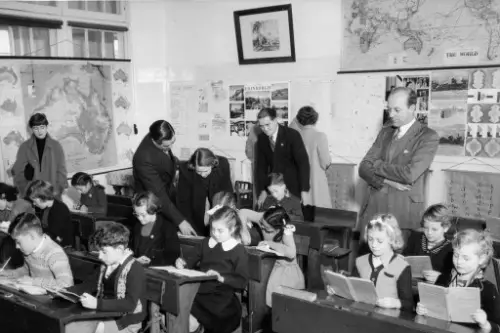
In the 1950s, teachers had near-total control over when and how often students could use the restroom. Many schools had strict policies allowing bathroom breaks only at designated times, and students often had to wait until recess or lunch to go. Some teachers even denied students permission to use the restroom, believing they were trying to skip class rather than actually needing to go. This led to many uncomfortable and even humiliating situations for students who genuinely needed a break.
Today, restricting bathroom access to this extent would be considered cruel and inappropriate. Schools now recognize that students have basic bodily needs that should not be arbitrarily controlled by teachers. Many modern policies emphasize student well-being, allowing them to use the restroom when necessary without excessive restrictions. The idea of forcing students to wait until a designated break time would likely spark outrage, particularly due to concerns about health and personal dignity.
13. Left-Handed Desks Didn’t Exist

In the 1950s, most school desks were designed exclusively for right-handed students, leaving left-handed children to struggle with awkward and uncomfortable writing positions. Since left-handedness was often discouraged, schools saw no need to provide accommodations for students who wrote with their left hand. Many left-handed students were forced to twist their arms uncomfortably or adapt to right-handed desks, often resulting in smudged handwriting and frustration. Some even faced ridicule for their difficulties.
Today, schools are much more inclusive and provide left-handed desks and supplies to accommodate all students. Education experts now recognize that handedness is a natural trait, and forcing left-handed students to conform to right-handed standards is unnecessary and harmful. While left-handed students still face some challenges, modern classrooms strive to be more accommodating. The lack of left-handed desks in the past highlights how little consideration was once given to individual student needs.
14. Married Women Couldn’t Teach in Some Schools
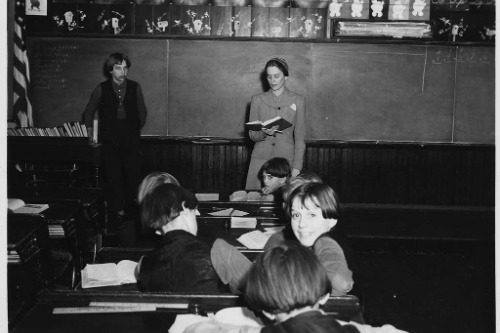
One of the most bizarre and sexist policies of the 1950s was the restriction on married female teachers. Many schools had rules that prohibited women from teaching if they were married, based on the outdated belief that a woman’s place was in the home. The expectation was that married women should focus on their husbands and families rather than having a career. Some teachers even had to hide their marriages or resign if they got married.
This rule would be unimaginable today, as gender discrimination in employment is now illegal. Women are free to pursue careers in education (or any field) regardless of their marital status. The idea that a woman’s ability to teach would be affected by marriage seems absurd by modern standards. This outdated rule reflects the broader societal expectations of the time, where women were often discouraged from having professional ambitions.


